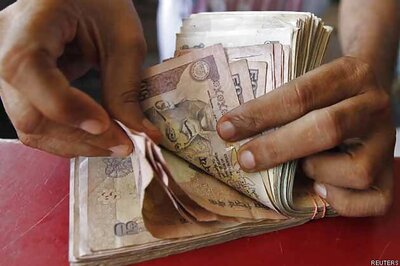
views
London: The uprisings that swept the Middle East this year have cost the most affected countries more than $55 billion, a new report says, but the resulting high oil prices have strengthened other producing countries.
A statistical analysis of International Monetary Fund (IMF) data by political risk consultancy Geopolicity showed that countries that had seen the bloodiest confrontations, Libya and Syria, were bearing the economic brunt, followed by Egypt, Tunisia, Bahrain and Yemen.
Between them, those states saw $20.6 billion wiped off their gross domestic product and public finances eroded by another $35.3 billion as revenues slumped and costs rose.
But as the major oil producers such as the United Arab Emirates, Saudi Arabia and Kuwait avoided significant unrest -- often through increasing handouts as oil prices rose -- they saw their GDP grow. Oil prices rocketed from around $90 a barrel of Brent crude at the start of the year to just short of $130 in May before retreating to around $113 now.
"As a result, the overall impact of the 'Arab Spring' across the Arab realm has been mixed but positive in aggregate terms," the report estimated, saying overall the year to September saw some $38.9 billion added to regional productivity.
Libya looks to have been the worst affected, with economic activity across the country -- including oil exports -- halted at an estimated cost to GDP of $7.7 billion, or more than 28 percent. Total costs to the fiscal balance were estimated at $6.5 billion, roughly 29 percent of gross domestic product.
In Egypt, nine months of turmoil eroded some 4.2 percent of gross domestic product with public expenditure rising to $5.5 billion just as public revenues fell by $75 million.
Handouts not reform?
In Syria, where protests have continued throughout the year in the face of a bloody crackdown, the impact is hard to model but early indications suggested a total cost to the Syrian economy of some $6 billion or 4.5 percent of GDP.
The report said the number of Yemenis below the poverty line was expected to be pushed above 15 percent as a result of currency falls and protracted unrest. Total cost to the economy was estimated at 6.3 percent of GDP, with the fiscal balance deteriorating by $858 million, 44.9 percent of GDP.
Tunisia, where the protests began in late 2010, lost some $2.0 billion from its GDP, roughly 5.2 percent, with negative impacts across almost all sectors of the economy including tourism, mining, phosphates and fishing. Tunisia's government increased expenditure by some $746 million, pushing its fiscal balance some $489 million into the red.
Saudi Arabia's newly instituted handouts and wider public investment programme, the report estimated, amounted to some $30 billion -- perhaps seen by the kingdom's rulers as a way of avoiding real reform. But increased oil prices and production helped boost gross domestic product by more than $5 billion and push up public revenues by $60.9 billion.
In Bahrain, oil helped cushion the impact of weeks of protest, with the fall in GDP relatively low at some at 2.77 percent. Public expenditure rose some $2.1 billion, partly because of cash transfers of $2,660 to each family.
None of these steps, the report argued, addressed the underlying causes behind the unrest. A better solution, it said, was much broader international support through the G20 or United Nations aimed at much wider reform.


















Comments
0 comment